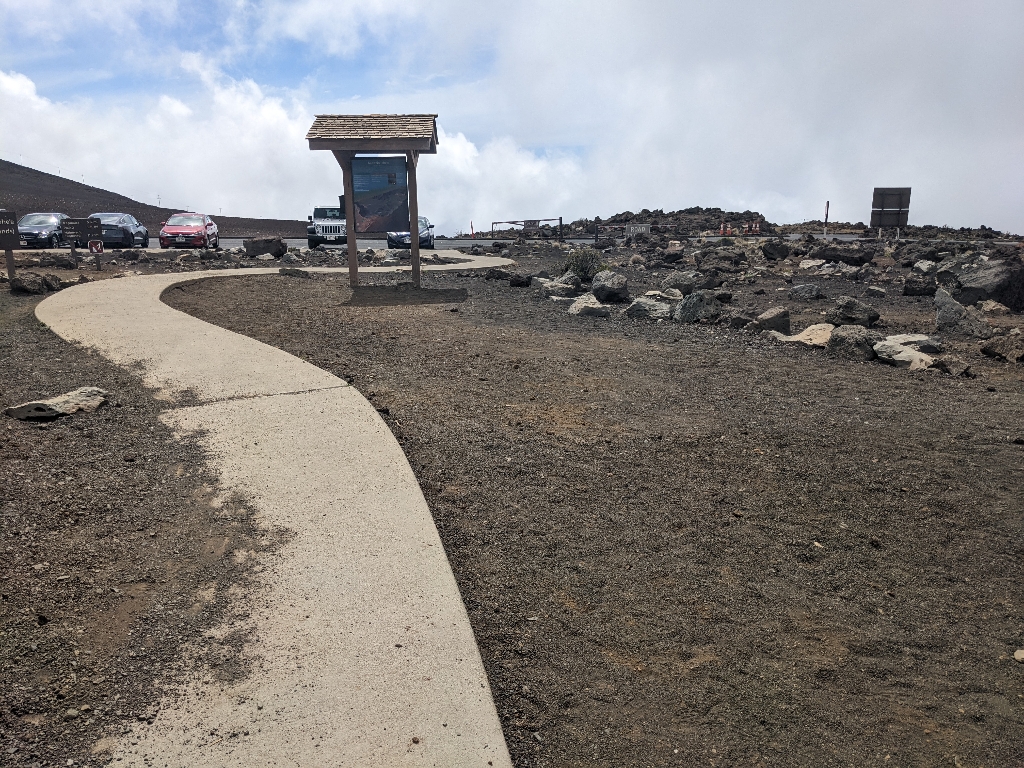
What is your favorite sparkling or carbonated beverage? Volcanic eruptions are just like your delightful bubbly beverage of choice. Check out the rocks at this stop to see the comparision in action. Keep in mind that these rocks are part of the park and should remain where you find them. It is culturally disrespectful and illegal to disturb or remove any rocks from Haleakalā.
When molten rock is deep underground, it’s called magma. The weight of the overlying rock keeps magma under immense pressure, dissolving gases like water vapor, carbon dioxide, and sulfur dioxide into the molten mixture. If the hot, pressurized magma reaches a weak spot in the crust above, it shoots up toward the surface. Pressure on the magma decreases as it rises, and the dissolved gases will reach a point where they change from liquid to gas form, expanding into bubbles inside the magma and forcing it to rise even faster. If it reaches the surface, it becomes lava!
Consider a glass bottle of champagne. An airtight container holds a fluid mixed with dissolved gas (carbon dioxide) under intense pressure without exploding. If you look through the glass, it only appears to be liquid. However, as you dramatically remove the cork, the contents that were under pressure now experience rapid decompression, and all of the dissolved gas suddenly explodes out of the top of the bottle as a spray of frothy bubbles. Compare the bottled liquid to magma underneath the volcano, and the explosion of foam and bubbles to the cooled lava on the ground at this stop.
If you take a close look at the lava rocks around this parking area, the many holes you see are bubbles frozen in time–they show where the gas was at the time of the eruption. As this lava flowed and cooled, the bubbles changed shape by joining together or stretching out. By observing the gas content of lava through features like these bubbles, scientists can estimate a lava flow’s likely movement, patterns, and speeds.
When molten rock is deep underground, it’s called magma. The weight of the overlying rock keeps magma under immense pressure, dissolving gases like water vapor, carbon dioxide, and sulfur dioxide into the molten mixture. If the hot, pressurized magma reaches a weak spot in the crust above, it shoots up toward the surface. Pressure on the magma decreases as it rises, and the dissolved gases will reach a point where they change from liquid to gas form, expanding into bubbles inside the magma and forcing it to rise even faster. If it reaches the surface, it becomes lava!
Consider a glass bottle of champagne. An airtight container holds a fluid mixed with dissolved gas (carbon dioxide) under intense pressure without exploding. If you look through the glass, it only appears to be liquid. However, as you dramatically remove the cork, the contents that were under pressure now experience rapid decompression, and all of the dissolved gas suddenly explodes out of the top of the bottle as a spray of frothy bubbles. Compare the bottled liquid to magma underneath the volcano, and the explosion of foam and bubbles to the cooled lava on the ground at this stop.
If you take a close look at the lava rocks around this parking area, the many holes you see are bubbles frozen in time–they show where the gas was at the time of the eruption. As this lava flowed and cooled, the bubbles changed shape by joining together or stretching out. By observing the gas content of lava through features like these bubbles, scientists can estimate a lava flow’s likely movement, patterns, and speeds.
Is there something we missed for this itinerary?
Itineraries across USA

Acadia

Arches National Park

Badlands

Big Bend

Biscayne

Black Canyon Of The Gunnison

Bryce Canyon

Canyonlands

Capitol Reef

Carlsbad Caverns

Channel Islands

Congaree

Crater Lake

Cuyahoga Valley

Death Valley

Dry Tortugas

Everglades

Gateway Arch

Glacier

Grand Canyon

Grand Teton

Great Basin

Great Smoky Mountains

Guadalupe Mountains

Haleakalā

Hawaiʻi Volcanoes

Hot Springs

Indiana Dunes

Isle Royale

Joshua Tree

Kenai Fjords

Kobuk Valley

Lassen Volcanic

Mammoth Cave

Mesa Verde

Mount Rainier

North Cascades

Olympic

Petrified Forest

Pinnacles

Rocky Mountain

Saguaro

Shenandoah

Theodore Roosevelt

Virgin Islands

Voyageurs

White Sands

Wind Cave

Yellowstone

Yosemite

Zion